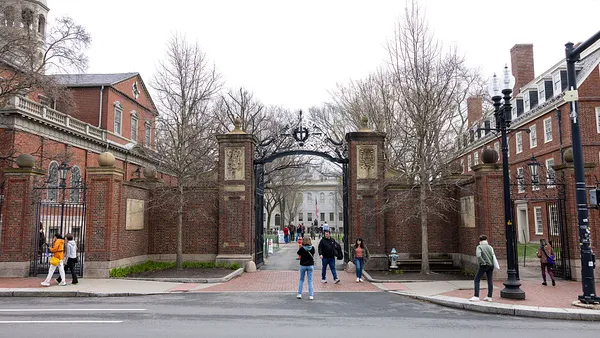Dive Brief:
- President Donald Trump's fiscal year 2020 budget proposal calls for a $7.1 billion — 10% year-over-year — cut in education spending, marking the third consecutive year of requested cuts. The figure excludes Pell Grant cancellations.
- The proposal eliminates the Public Service Loan Forgiveness (PSLF) program and subsidized loans, suggests college share some responsibility for loans with students, and asks to streamline income-based repayment options into a single entity. It also seeks to expand Pell Grant eligibility to short-term programs, and to consolidate the TRIO and GEAR UP programs into a single grant.
- Also in the president's proposal are efforts to invest in workforce education, including for STEM and coding-focused career and technical programs, and by re-orienting the Federal Work-Study program around "workforce and career-oriented training."
Dive Insight:
The budget is, of course, the president's request to Congress and therefore will be debated and likely altered significantly before reaching its final form. Nonetheless, it indicates the priorities of the executive office at a critical moment for higher ed policy.
Congress has been stymied over a rewrite of the Higher Education Act (HEA), which was last authorized by Congress in 2008 and extended since then. But Hcouse and Senate leaders have said they're interested in another attempt at reauthorization — including Sen. Lamar Alexander, R-Tenn., who is chairman of the Senate's education committee and has indicated he would like to pass legislation before he retires at the end of this term.
The House and Senate education committees have each set up hearings to discuss HEA reauthorization. However, prior proposals from each have been at-odds and some observers worry that a rush to compromise will leave the resulting legislation without teeth.
The 2020 budget proposal throws a little weight behind the reauthorization push, stating: "These proposals would support congressional efforts to modernize and reauthorize the Higher Education Act to be responsive to the needs of both students and employers."
Trump's budget pitch has received pushback from some corners. In a statement Monday, American Council on Education President Ted Mitchell called the cuts "draconian" and a move away from "adequately investing" in financial aid and research.
James Kvaal, president of The Institute for College Access and Success (TICAS), told The Chronicle of Higher Education that the proposed cuts are "wrong-headed" and reflect "a disconnect" between the desire to restructure the Federal Work-Study program and the cost of doing so.
"These deep cuts overshadow otherwise worthwhile changes, such as automatically enrolling distressed borrowers in income-driven repayment, automating the annual income recertification process, and modernizing student loan servicing," according to a statement by TICAS on Monday.
The budget eliminates funding for 29 discretionary programs, which, the administration said, would "decrease taxpayer costs by $6.7 billion." They include the Supporting Effective Instruction State Grants, 21st Century Community Learning Centers and the Federal Supplemental Education Opportunity Grants.
However, Inside Higher Ed notes, Congress has previously bucked the president's calls for higher ed cuts and instead bolstered spending for programs such as Pell Grants, TRIO and GEAR UP.













